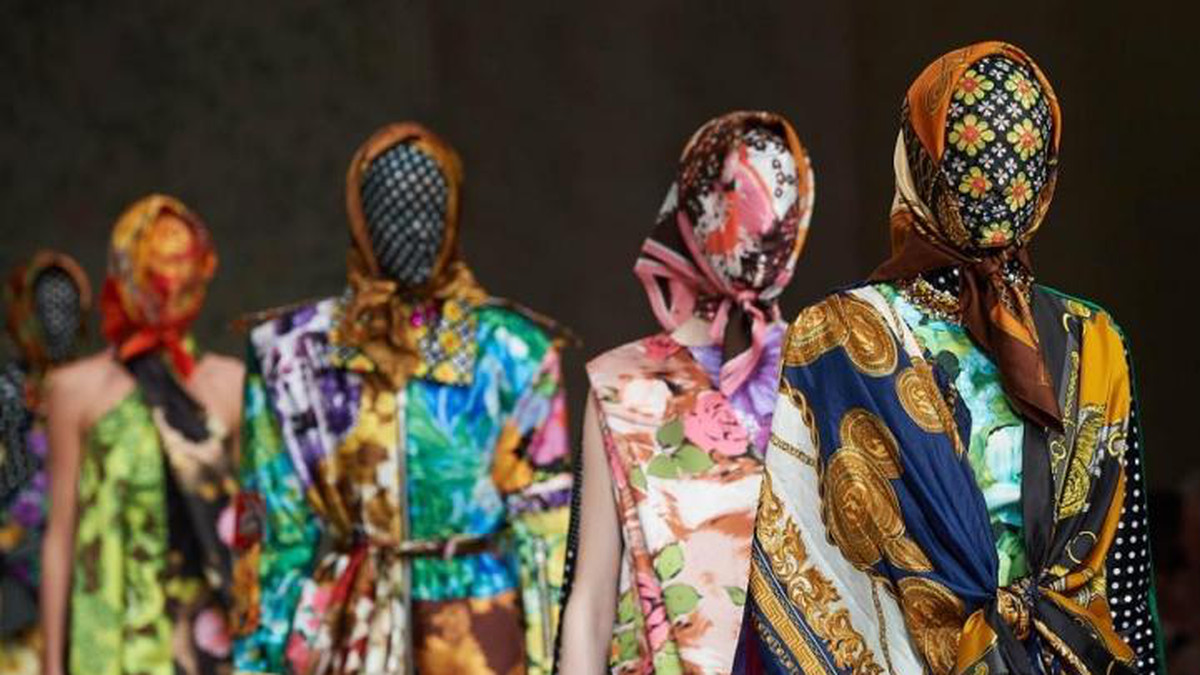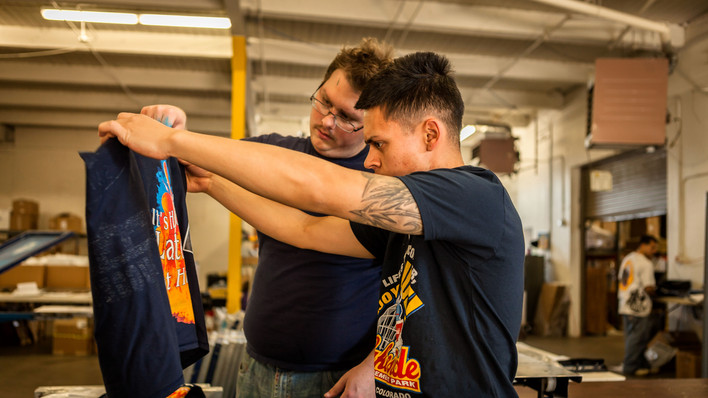The fashion and textile world is rapidly evolving with new advances in technology every day. Read on to learn how one fashion designer leverages Epson digital printing technology to bring luxury looks to life.
Last season at London Fashion Week, Richard Quinn’s name was catapulted into the spotlight thanks to a VIP front-row guest that most designers with many more years in the business could only dream of. Her Majesty the Queen attended her first-ever catwalk at the biannual fashion gathering to present him an award after the show and the news went viral. Six months on, he’s now hotly tipped as “one to watch” by the industry, and while the Queen may not be at his show today, the buyers will be.
“I don’t think a two-hour lecture every week about business and how to sell your designs would have helped me in the slightest, like, at all,” says Quinn at his studio and print room in South London’s trendy Peckham neighborhood. In recent years, design schools have been criticized for not preparing students for the business of the industry. A 2015 survey by the Business of Fashion found that only 57% of fashion students questioned were happy with their university’s careers service. Quinn, only two years out of art school himself, rolls his eyes at the suggestion it should become part of the syllabus. “I think I got all my business knowledge from my dad,” he says. His father runs a scaffolding company in a neighboring railway arch by Quinn’s studio. “I think business is 95% intuition and common sense.”
While there are certainly many more lessons still to be learnt in his fledgling business, he’s off to a start that many new graduates dream of. Quinn’s name has barely been out of the headlines since the prize’s namesake presented him with the Queen Elizabeth II Award for British Design. “It had a huge reach, further than I thought it was going to go,” he reflects. “I thought one or two papers would be like, ‘Ha-ha, look at this,’ but then my friends were in New York and Asia and they were literally sending me (pictures of) news buildings with my name going around it.” In the months that followed he dressed Amal Clooney for the Met Gala, the most-watched red-carpet event for fashion, and launched collaborations with department stores Liberty and Debenhams. The hype is transferring into sales, too. He launched his first season with 15 stockists and this current season they’ve expanded to around 50, which include prestigious stores such as MatchesFashion.Com, Dover Street Market, Lane Crawford and Opening Ceremony.
In many ways, Quinn’s route into launching his label is typical of a British designer. He completed the famous Fashion MA at Central Saint Martin and won the H&M Design Award in 2017, which granted him €50,000 ($58,000) to invest in his business. His business’ model though, encompassing design and manufacturing, is more unusual for a new fashion brand.
“My whole idea was to have a print room and a womenswear label that runs alongside it. Before you actually do it, it sounds like a big feat, but in actual reality, one feeds into the other,” he says, referencing the bold colorful prints that dominate his collections. It’s the print studio, open to students and professionals as well as used for their own creations, which initially provided important revenue. Now the success of the womenswear label is taking over but the printing facilities will remain an important part of the business and the brand. “I like London, I grew up around here. It’s what I want to do. I’ve actually got a skill. I’m not going to sit in front of a computer sending it to Italy talking about a screen print. Why don’t I just buy some screens and do it myself?”

Queen Elizabeth II presents Richard Quinn the inaugural Queen Elizabeth II Award for British Design. Photo by: KGC-375/STAR MAX/IPx
The surrounding area is quickly filling with art studios and cool independent labels as it gentrifies, but facilities for production are almost nonexistent and could be a promising opportunity for Quinn, as much as a personal desire to bring skill and craft back to his hometown. He pays a living wage to his employees too, something which Quinn describes as “just standard, really,” but as many at the bottom rung of the industry know, is often not the case in other brands who rely heavily on unpaid interns. Currently Richard Quinn employs just three full-time staff, including Quinn and his sister, as well as one placement student. But he hires freelancers in when additional help is required and pays an agency to handle PR.
Expanding is on the horizon, though. “We will need to grow quite soon. There’s only so much we can do,” he says. “It’s nice if (the print studio) business grows with the other business. The womenswear, obviously, is naturally taking over really quick in terms of sales, which is obviously causing problem with, like, space. At the time this (space) was great, but maybe now we move? A bigger space, more windows. But obviously, I don’t want to go too quick and then be stuck and be like, Ah, this was a flash in the pan. I’d rather just utilize the space I’ve got, make money out of the space I’ve got and then when it’s like, absolutely need to move, then I’ll move.”
A number of big designer houses have been buying and opening manufacturing units in order to improve business recently. In May, Burberry announced it would be buying its Italian leather-goods factory to have greater control over “quality, cost, delivery and sustainability.” Last November, LVMH announced it would open more factories in Italy to expand production for Fendi and Céline, bringing their total number of manufacturing facilities in the country to 24. Owning your supply chain seems to be a luxury reserved for multimillion-dollar fashion houses, but Quinn is proving it can work on a small scale, too.
Initially Quinn bought a couple of second-hand printing machines to get the studio started, but a savvy partnership with Epson has made it top class. In exchange for printers, Quinn hosts talks with the company and allows his space to be used as a showroom to demonstrate the machines in a working environment to potential customers. For Epson, working with a luxury designer label is also a chance to promote its ability to produce high-end results, something which Quinn felt was previously missing for the company. “A lot of their textile software was aimed at mass production of either cycling tops or T-shirts or things like that. Whereas I approached them and said, look at my MA collection. I’ve got a lot of interest from these publications. It’s like a different sector of the market that you’re not currently reaching. And it’s the best advertisement.”

Quinn’s bold, colorful prints are created at his own London printing facility. Photo by: KGC-247/STAR MAX/IPx 2018
He hopes the print studio will future proof his business too and he shows a working-class sensibility to always have a back-up plan. “Even if my womenswear line literally fails now, goes down the toilet, whatever, or I don’t want to do it anymore, I’ve still got a business here that makes money. So it’s, like, it’s just intelligent having two sides to things.”
While some brands might be hesitant to let competitors into their working space for fear of jeopardizing their IP, Quinn says he has no interest in participating in the trend of fashion students’ and young brands’ calling out luxury houses for copying them. “We live in that age where everything’s available, I think, and everything is recycled to an extent. So if anyone ever copies us, we’d just kind of laugh at it and we’ll move on to the next.” Even once the brand grows, Quinn finds the concept of fake designer goods more of a fascination than a threat. “I grew up in a world where people would go down to Woolwich market and buy a fake Gucci wallet, but there was still credibility in that. It was still, like, you’re aspiring to that. That to me is a business.”
Quinn admits there’s no business plan in place for the moment, though. The unpredictability of the first few years, while fortunately going far better than expected for Quinn, have left his plans very much down to the intuition and common sense he cited. “I haven’t been doing this a year yet, because I showed my first season in September. Once we know what sells, I’d say it’d be wise to do some sort of forecast. Once we do autumn/winter 19 sales […] then you’ll know the trajectory of everything. We already have pieces that we’re like, That’s a winner. Do it in a different print, it’ll 100% sell. So we already know our kind of hero pieces within it and now we’re just trying to figure out what’s next, what can we elevate, what can we push, what can we hold back for a few seasons. And until we do it for a few seasons there’s no way to gauge that, I don’t think.”
Quinn has a cautiousness and patience that’s surprising given the hype frenzy of press, awards and celebrities that has surrounded him in the first year of his brand. He’s thankful for all the support but he’s also mindful of focusing on what’s important. If he isn’t on the way to becoming one of Britain’s star fashion designers, he’s at least on the way to building a much-needed printing facility in the capital, and that’s no small contribution to the industry.
This article was written by Olivia Pinnock from Forbes and was legally licensed through the NewsCred publisher network. Please direct all licensing questions to legal@newscred.com.
![]()



